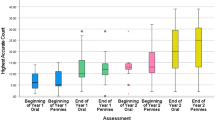Abstract
Developmental and school-related changes in basic number, counting, and arithmetic skills from infancy to old age are reviewed. Nearly all of the quantitative competencies that emerge during infancy and the pre-school years appear to reflect the operation of a biological primary, or inherent, cognitive system, and appear to be universal in their expression and development. In contrast, most of the basic quantitative competencies acquired in school and that are of importance in industrial societies do not have a direct inherent foundation. As a result, the development of these secondary quantitative abilities varies considerably with educational practices and can, and often does, vary from one country or generation to the next. Variability in the development of secondary quantitative abilities greatly complicates the study of the relation between pathological (e.g., dyscalculia due to stroke) and age-related processes and these abilities.
Similar content being viewed by others
References
Antell SE, Keating DP (1983) Perception of numerical invariance in neonates. Child Development 54: 695–701
Bahrick HP (1993) Extending the life span of knowledge. In: Penner LA, Batsche GM, Knoff HM, Nelson DL (eds) The Challenge in Mathematics and Science Education: Psychology’s Response (pp 61–82). Washington, DC: American Psychological Association
Bahrick HP, Hall LK (1991) Lifetime maintenance of high school mathematics content. Journal of Experimental Psychology: General 120: 22–33
Bishop JH (1989) Is the test score decline responsible for the productivity growth decline? American Economic Review 79: 178–197
Boissiere M, Knight JB, Sabot RH (1985) Earnings, schooling, ability, and cognitive skills. American Economic Review 75: 1016–1030
Boysen ST, Berntson GG (1989) Numerical competence in a chimpanzee (Pan troglodytes). Journal of Comparative Psychology 103: 23–31
Fuson KC (1988) Children’s Counting and Concepts of Number. New York: Springer-Verlag
Fuson KC, Kwon Y (1992) Korean children’s understanding of multidigit addition and subtraction. Child Development 63: 491–506
Gallistel CR, Gelman R (1992) Preverbal and verbal counting and computation. Cognition 44: 43–74
Geary DC (1994) Children’s Mathematical Development: Research and Practical Applications. Washington, DC: American Psychological Association
Geary DC (1995) Reflections of evolution and culture in children’s cognition: implications for mathematical development and instruction. American Psychologist 50: 24–37
Geary DC (1996) International differences in mathematical achievement: their nature, causes, and consequences. Current Directions in Psychological Science 5: 133–137
Geary DC, Frensch PA, Wiley JG (1993) Simple and complex mental subtraction: strategy choice and speed-of-processing differences in young and elderly adults. Psychology and Aging 8: 242–256
Geary DC, Hamson CO, Chen GP, Liu F, Hoard MK, Salthouse TA (1997) Computational and reasoning abilities in arithmetic: cross-generational change in China and the United States. Psychonomic Bulletin & Review 4: 425–430
Gelman R (1990) First principles organize attention to and learning about relevant data: number and animate-inanimate distinctions as examples. Cognitive Science 14: 79–106
Gelman R, Gallistel CR (1978) The child’s Understanding of Number. Cambridge, MA: Harvard University Press
Lewis AB (1989) Training students to represent arithmetic word problems. Journal of Educational Psychology 81: 521–531.
Mayer RE (1985) Mathematical ability. In: Sternberg RJ (ed) Human Abilities: An Information Processing Approach (pp 127–150). San Francisco, CA: Freeman
Miller KF, Smith CM, Zhu J, Zhang H (1995) Preschool origins of cross-national differences in mathematical competence: the role of number-naming systems. Psychological Science 6: 56–60
Miura IT, Okamoto Y, Kim CC, Steere M, Fayol M (1993) First graders’ cognitive representation of number and understanding of place value: cross-national comparisons — France, Japan, Korea, Sweden, and the United States. Journal of Educational Psychology 85: 24–30
Paglin M, Rufolo AM (1990) Heterogeneous human capital, occupational choice, and male-female earnings differences. Journal of Labor Economics 8: 123–144
Rivera-Batiz FL (1992) Quantitative literacy and the likelihood of employment among young adults in the United States. Journal of Human Resources 27: 313–328
Seron X, Fayol M (1994) Number transcoding in children: a functional analysis. British Journal of Developmental Psychology 12: 281–300
Sharon T, Wynn K (1998) Individuation of actions from continuous motion. Psychological Science 9: 357–362
Siegler RS, Shrager J (1984) Strategy choice in addition and subtraction: How do children know what to do? In: Sophian C (ed) Origins of Cognitive Skills (pp 229–293). Hillsdale, NJ: Erlbaum
Simon TJ, Hespos SJ, Rochat P (1995) Do infants understand simple arithmetic? A replication of Wynn (1992) Cognitive Development 10: 253–269
Starkey P (1992) The early development of numerical reasoning. Cognition 43: 93–126
Starkey P, Spelke ES, Gelman R (1990) Numerical abstraction by human infants. Cognition 36: 97–127
Strauss MS, Curtis LE (1984) Development of numerical concepts in infancy. In: Sophian C (ed) Origins of Cognitive Skills: The Eighteenth Carnegie Symposium on cognition (pp 131–155). Hillsdale, NJ: Erlbaum
Temple E, Posner MI (1998) Brain mechanisms of quantity are similar in 5-year-old children and adults. Proceedings of the National Academy of Sciences USA 95: 7836–7841
Wynn K (1992) Addition and subtraction by human infants. Nature 358: 749–750
Wynn K (1996) Infants’ individuation and enumeration of actions. Psychological Science 7: 164–169
Author information
Authors and Affiliations
Corresponding author
Rights and permissions
About this article
Cite this article
Geary, D.C. From infancy to adulthood: the development of numerical abilities. European Child & Adolescent Psychiatry 9 (Suppl 2), S11–S16 (2000). https://doi.org/10.1007/s007870070004
Issue Date:
DOI: https://doi.org/10.1007/s007870070004




